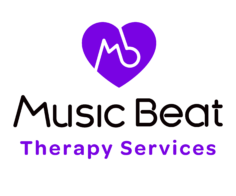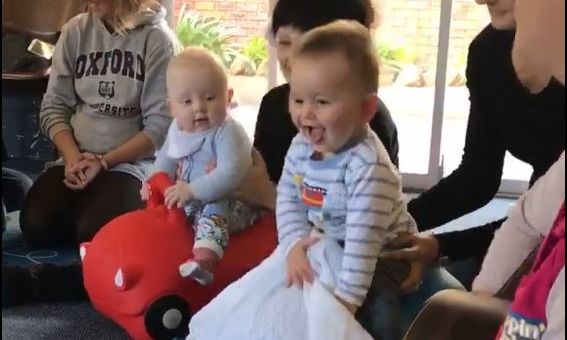Some of you may have seen this delightful video we posted on Facebook recently. In this video, Master J is singing along with me as he bounces on the little red cars we use at Boppin’ Babies.
Many people commented on this post and have also asked me “what is actually going on?” They can see there is something really magical happening here, and want to know more. So, I thought I would explain in a little more detail for those who find the ways that music supports early childhood development as fascinating as I do!
To begin, I should explain, as a music therapist my approach to music and babies is informed by the belief that children are innately musical and my job is to support that and then use it to support and enhance development.
To do this we use music in gentle ways that are not overwhelming or overstimulating to little growing brains.
That is why our music is played live, as that allows us to follow the lead of the children rather than dictate what they must do in that moment.
What do I mean?
Music enhances gross motor and coordination skills
Here you can see we are doing a movement to music activity, where the little bubbas bounce up and down on their cars in time to the music.
We are predominately focused on gross motor and coordination skills here, as you can see, it takes a lot of balance and skill to drive these little cars!
If you watch closely you will see the babies are bouncing in time with me. Actually, they are too young to change the beat themselves, so what you are actually seeing is me moving in time with them (and their parents of course following that beat).
In music therapy we call this entrainment, we are in sync rhythmically. Once this is happening, other magical things begin too. One is the children work on their innate musicality by keeping in beat with their body, they learn kinesthetically what beat feels like.
We are also working on non-musical skills like the obvious balancing, and grasping work you can see in the video.
Then, the most beautiful thing begins to happen – Master J starts vocalising as he bounces along.
Music helps us connect
Because the music is live, I am able to adapt the words of this traditional song to reflect what he is doing in the song.
Notice how he engages with me, with a big smile and leaning towards me as we both move together in the music (yes I know I bounce a LOT when I sing!).
When I use his name, we make a real connection and begin to sing. I create a space for him to sing by improvising a musical pattern on the guitar that maintains the same beat (so we are entrained) and paces the group to hold and be in that moment.
I then use a (predominately) descending vocal motive, as babies find it much easier to sing down pitches than up, and pause to allow him the space to hear what I am doing, and respond. He does so with gusto!
After the second phrase he sings along with that beautiful smile! I then match the shape of his vocalisation when I sing the third phrase, and again, pause musically and wait for his response. We have a beautiful musical moment where we are engaged and creating a little song together.
For years I have been watching this phenomena where little bubbas start vocalising and ‘singing’ with me when they are physically engaged on the therapy balls or Bop Alongs like this.
Music helps our brains to process experiences, memories and emotions
One of the mums in our group is a physiotherapist, and she recently explained that the areas in the brain that process movement and speech are structurally close together and this might be a reason why.
The cerebrum is the largest part of the brain, and controls speech and movement. The cerebrum is divided into two hemispheres and then four sections called lobes. Each section is involved in processing different sensory experiences, memories and emotions.
So what you see here looks like a little fellow being bounced along and maybe squealing with delight.
What I see is a mum and her bub that are moving together in time to the music, live music that I am creating in order to support their capacity to be together, in this moment and create precious musical memories.
Music makes us happy
I see a mum who is taking delight in her child (and who will likely go home now and repeat this song while bouncing her baby on her knee). When she smiles and laughs her oxytocin levels (feel good hormones) rise in her brain, so she feels happier and a little more in love with her little bubba.
I see a baby who is moving musically and rhythmically with his mother, being physically held and touched by her, and who is participating in several developmental tasks at once with me. He is vocalising, moving, balance, looking around, responding to visual, auditory and social cues to name just a few.
He is working very hard, but he is very happy too! The gentle live approach of the music, provided through multi-modal stimulation means that he is not over stimulated in this moment.
Live music is best for your bub
If I used recorded music, I would not be able to change the beat, and the layering of instrumentation, voices and tracks may be too much from an auditory perspective.
As Miss Chare said the day she happened to capture this moment, “there is something magical about this. Master J is not just singing, he is using his voice to participate in a beautiful musical interaction which has been created by both him and you”.
We love allowing your child to engage and express within the musical space we provide because it’s moments like these that just get our hearts melting.

